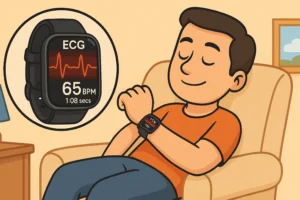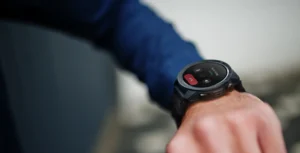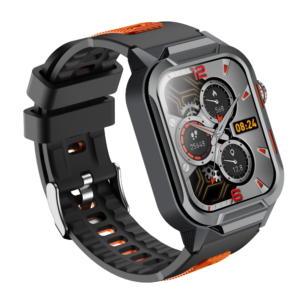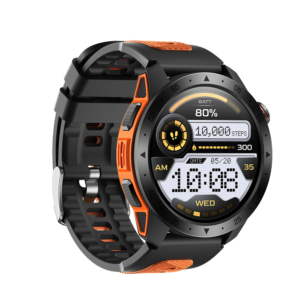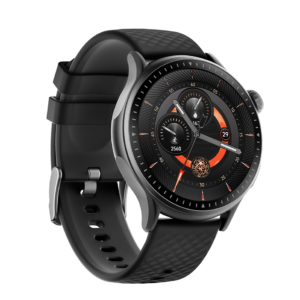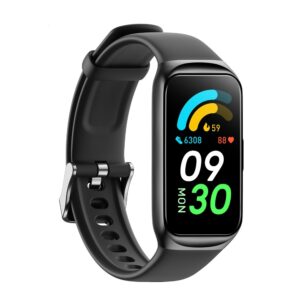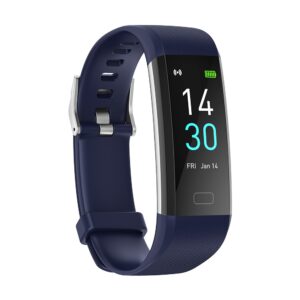There’s a widening gap between what smartwatch buyers want and what many OEMs are still building. Buyers are tired of clunky interfaces, uninspiring designs, and devices that overpromise and underdeliver. There are hundreds of products hitting the market without nailing the core features that influence buying decisions. This leads to high return rates, stagnant sales and missed opportunities.
This article will ensure you don’t fall into this trap. The brands winning today are the ones that listen closely, adapt quickly, and build for real-world needs. Let’s unpack what truly matters to tech-savvy consumers and features you must prioritise to meet the needs of your target audience.
What Smartwatch Buyers Really Want
- Productivity Features
In 2025, smartwatch buyers need more than fitness stats and stylish bands. Yes, it’s great to have those figures showing your fitness level, but buyers want a device that keeps up with their workday. Productivity features have become a core expectation, especially among professionals and multitaskers. A high percentage of smartwatch users now use their device for productivity-related tasks daily, and that number is steadily growing as more people adopt hybrid work setups.
Smartwatches that make it easier to organise, respond, and stay on track are commanding more attention, with higher price tags, of course. Buyers want to feel like their wearable is earning its place on their wrist. Top productivity sub-features users now expect include:
- Calendar integration with real-time meeting notifications and updates
- Voice assistant access for hands-free scheduling and replies
- Smart notifications that are actionable, like quick replies to texts or emails
- Third-party productivity app sync, such as Slack, Trello, and Microsoft Outlook
- Custom work profiles or focus modes to filter distractions during key hours
- On-device task tracking with to-do lists and reminders
Take Apple Watch Series 9, for example. With on-device Siri, Smart Stack widgets, and seamless integration with Apple Calendar, Reminders, and Mail, it becomes a powerful tool for daily tasks. For any OEM developing new models, you can’t afford to ignore the appeal of productivity.
- Sport Tracking
Sport tracking is one of the top-selling features for any smartwatch. With more users prioritising health, performance, and outdoor mobility, comprehensive fitness tracking features now rank high on consumer expectations. About 80% of smartwatch users globally use smartwatches to monitor their daily steps. For this, accuracy and real-time feedback are super important.
Buyers are no longer satisfied with step counts and basic heart rate data. They want precision-grade features that help them train smarter. Here’s what they’re looking for:
- Multi-sport mode support (running, cycling, swimming, yoga, etc.)
Consumers expect smartwatches to adapt to their active lifestyle, whether they’re runners, swimmers, or yogis. Top devices support more than 100 workout types, with tailored metrics for each. This allows users to log diverse routines with the accuracy and depth they’d get from sport-specific devices.
- Automatic workout detection without manual input
Busy users love when their smartwatch can auto-detect activities like walking, running, or cycling. This eliminates the need to start or stop a workout manually, ensuring no activity goes untracked. Brands like Fitbit and Samsung lead in this area with highly responsive motion algorithms.
- VO2 max and performance metrics for endurance athletes
Advanced metrics like VO2 max, cadence, and recovery time help serious users optimise training. Garmin’s sports range is widely respected for delivering these analytics with near-professional accuracy.
- GPS-based pace and route tracking for outdoor sports
Integrated GPS lets users map their route, pace, elevation, and distance without needing a phone. This is a crucial feature for runners, cyclists, and hikers. Devices like the Apple Watch Ultra and Polar Vantage series offer multi-band GPS for even greater precision.
- Post-workout recovery suggestions using heart rate variability (HRV)
Smart recovery is as important as the workout itself. By measuring HRV, top smartwatches offer insight into stress, sleep quality, and when to train or rest.
The Garmin Forerunner 965 stands out for triathletes with its precise GPS, wrist-based running dynamics, and stamina insights during long runs. Meanwhile, the Huawei Watch GT 4 impresses casual fitness fans with over 100 workout modes, customisable training plans, and intelligent reminders to move. You can mirror these features to ensure that your smartwatches have what most buyers really want.
- Health Monitoring
Health monitoring remains one of the most powerful purchase drivers for modern smartwatch buyers. As consumers become more wellness-conscious, smartwatches are evolving from simple fitness trackers into sophisticated personal health companions. A 2024 Global Health Survey found that 58% of wearable users in the U.S. rely on their device to monitor chronic conditions or detect early health warnings.
Some top features related to health monitoring are:
- Heart Rate Monitoring (HRM)
Advanced HRMs offer real-time alerts for high/low heart rates and irregular rhythms. The Apple Watch Series 9, for instance, includes FDA-cleared notifications for atrial fibrillation (AFib), which can be life-saving.
- SpO2 (Blood Oxygen Saturation)
Especially post-COVID, SpO2 tracking has become a critical feature. It helps monitor sleep apnea, respiratory issues, and general respiratory health. It is a great idea to have consistent overnight and on-demand SpO2 readings.
- ECG Monitoring
Electrocardiogram (ECG) functionality enables users to detect signs of atrial fibrillation and other cardiac irregularities. Devices like the Samsung Galaxy Watch6 are FDA-approved for this feature. A study in The Lancet (2023) supports wearable ECGs as reliable for AFib detection when compared to clinical tools.
- Stress and HRV Tracking
Smartwatches now use Heart Rate Variability (HRV) to measure physiological stress levels. This data powers stress scores, guided breathing sessions, and personalised recovery suggestions. The information can help users optimise mental and physical resilience.
- Sleep Tracking with Sleep Staging
Accurate detection of light, deep, and REM sleep phases offers insights into recovery and long-term health trends. The Apple Watch offers detailed sleep analysis that aligns closely with polysomnography studies.
There are several hybrid smartwatch health monitoring devices, offering SpO2, ECG, temperature, and respiratory tracking in a classic watch form. Meanwhile, the Samsung Galaxy Watch6 combines medical-grade sensors with AI-driven wellness nudges, appealing to health-conscious users of all ages.
- Real-Time Notifications
It is incredibly convenient to have easy access to notifications across multiple apps without staring at a smartphone screen. Today’s smartwatch buyers prioritise instant, actionable alerts that reduce screen time and increase personal efficiency. According to Statista, about 54% of wearable tech users in the U.S. value smartwatches primarily for on-wrist notifications, whether for calls, texts, app alerts, or health updates.
Here’s what makes real-time notifications a critical selling point:
- Call and Message Alerts
Whether you’re in a meeting or on a run, being able to check incoming calls and messages on your wrist discreetly is invaluable. Smartwatches like the Apple Watch Series 9 and Samsung Galaxy Watch6 allow users to respond via voice, quick replies, or emojis without pulling out a phone.
- App and Calendar Notifications
Seamless integration with platforms like Gmail, Slack, WhatsApp, or Microsoft Teams ensures you’re always synced with your schedule and team. Productivity-driven users prefer watches that allow granular control over what apps can send alerts and how.
- Health and Safety Alerts
Advanced smartwatches send real-time alerts for abnormal heart rates, high stress levels, AFib detection, and even potential falls. The Apple Watch’s fall detection feature has reportedly saved lives by auto-alerting emergency contacts or services.
- Navigation Prompts
Smartwatches with GPS capabilities like the Garmin Forerunner or Pixel Watch 2 offer on-wrist turn-by-turn directions, haptic nudges, and traffic updates, keeping users focused and hands-free.
- Payment Confirmations
With contactless payments becoming mainstream, real-time transaction alerts help prevent fraud and boost confidence. Smartwatches supporting Apple Pay and Google Pay notify users immediately after each purchase.
We have one more fantastic example. The Samsung Galaxy Watch6 stands out for customisable notifications, auto-muting alerts during sleep or workouts, and delivering timely nudges to move, hydrate, or check stress. Receiving the right alerts at the right time is truly a game-changer for smartwatch tech buyers.
- AI-Powered Features
Artificial Intelligence is redefining what a smartwatch can do. Now it’s more about being a predictive companion rather than a reactive device. According to Deloitte’s 2024 report on wearables, 70% of smartwatch users say AI-powered personalisation and insights significantly enhance their experience and loyalty to a brand.
Here are some ways AI-powered features are becoming essential:
- Predictive Health Insights
AI algorithms analyse sleep, heart rate variability, blood oxygen, and stress trends to forecast potential health issues. For example, Fitbit’s AI engine predicts breathing irregularities that could indicate sleep apnea well before symptoms are noticeable. This is especially useful as more than 70% of wearable users buy the device to monitor their health and nutrition, according to Deloitte. For most chronic conditions, early detection can be the difference between life and death.
- Smart Activity Recognition
Devices like the Garmin Venu 3 use AI to auto-detect whether you’re walking, biking, or lifting weights. They take it a step further by logging it without needing manual input. This reduces friction and ensures higher data accuracy.
- Personalised Wellness Coaching
AI learns your habits over time and delivers tailored reminders, workout suggestions, and recovery tips. These devices use machine learning to guide users on when to train or rest, optimising athletic performance based on strain and recovery metrics.
- Voice Assistance & Natural Language Processing (NLP)
AI-powered assistants (like Google Assistant or Siri) are now more context-aware. They can understand nuanced commands, predict user intent, and offer intelligent responses. With simple voice commands, users can make smartwatches their control tower, easily syncing this with their smart home tech and other devices.
At Starmax Technology, we take AI integration a step further. The Runmefit app, developed in-house, now includes integrated AI analysis that brings real-time, personalised health insights to the forefront. Whether it’s forecasting stress trends or adjusting activity suggestions based on your habits, this technology is built to support OEM partners looking to add real intelligence to their devices. Join successful smartwatch manufacturers like Starmax in 2025 by turning raw data into meaningful, predictive insights using AI.
The Role of AI and Predictive Wellness
Predictive wellness is an upcoming trend with smartwatches that many users are paying attention to. It is super important that it deserves to be talked about comprehensively. This trend is driven by a growing demand for personalised, proactive healthcare, with reports estimating that AI in wearable health could reach a $34 billion market by 2026.
Predictive wellness means your smartwatch no longer records what’s happening but anticipates what could happen. AI models analyse massive data points such as resting heart rate, sleep patterns, blood oxygen, and skin temperature to flag abnormalities before symptoms arise.
Wearables like the Apple Watch Series 9 are now capable of flagging potential heart arrhythmias or elevated stress markers. Google Pixel Watch’s AI learns your habits and suggests tailored mindfulness sessions or breathing exercises based on your stress profile. But with Starmax Technology’s smartwatch and Runmefit app, you can access a ready-made AI wellness engine that scales with your needs.
Brands that embed AI deeply into their operating systems and sensor analysis can offer far more than fitness metrics. That extra peace of mind is what today’s buyers value most.
Features OEMs Often Overlook But Shouldn’t
In the race for innovation, some of the most sought-after features often go under the radar. While flashy specs get the spotlight, it’s the quietly powerful features that drive loyalty. For OEMs, overlooking these could mean missing out on what actually delights long-term users.
Here are two underrated features that are quietly becoming key differentiators:
- Offline GPS
Runners, cyclists, and outdoor enthusiasts love going phone-free. Offline GPS allows them to track routes even in areas with no cell service.
- Contactless Payments
With mobile payment adoption reaching 51% globally according to Statista, integrating NFC tech into smartwatches should be a priority. Watches like the Samsung Galaxy Watch 6 offer seamless tap-to-pay functions, making wallets obsolete during runs or errands.
These often-overlooked features provide daily convenience, enrich user experience, and often become the reason users stick with a brand.
Conclusion
For OEMs, staying relevant means prioritising features that are considered useful in the real world. Buyers want sleeker yet smarter smartwatches. They’re looking for predictive wellness, AI-enhanced personalisation, and robust productivity tools that simplify their day. So, one of the best ways to stand out and keep winning in this market is to double down on AI-driven insights to support health, stress, and productivity in actionable ways.
Starmax Technology is here to help make that happen. With AI-powered tools like the Runmefit app, partners can turn raw sensor data into actionable insights that improve users’ health, productivity, and peace of mind.
The smartwatch of the future will anticipate needs, reduce friction, and help users lead healthier, more informed lives. Merchants and brands that can deliver on this promise will be the biggest winners.





